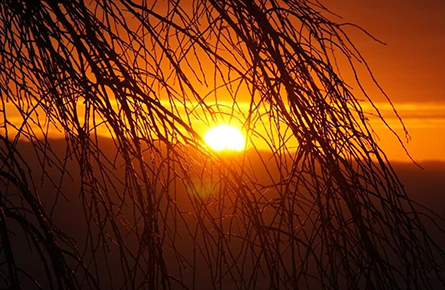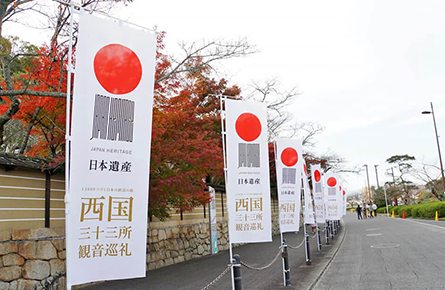The Beginning of
the Saikoku Kannon
Pilgrimage
The Saikoku Kannon Pilgrimage consists of thirty-three temples that enshrine Kannon Bodhisattva. They were chosen by Enma, the king of the world of the dead.
The pilgrimage route, which covers seven prefectures (Kyoto, Osaka, Wakayama, Nara, Hyogo, Shiga, and Gifu) is Japan's oldest. It was certified as a Japan Heritage Site in May 2019.
The Pilgrimage's Beginnings: Deities and People
-
King Enma
Enma, the king of the underworld that punishes the deceased for transgressions in their life, gave precious seals to Tokudo Shonin and ordered him to spread Kannon religious beliefs and practices.
-
Kannon Bodhisattva
Kannon is a bodhisattva that saves all kinds of people.
It is said that Kannon changes into thirty-three forms to save people from agony and suffering. This is why there are thirty-three stops on the pilgrimage route. -
Tokudo Shonin
Tokudo Shonin is the Buddhist priest that founded the temple Hasedera. He received precious seals from Enma in the underworld.
-
Emperor Kazan
Emperor Kazan, Japan's sixty-fifth emperor that entered the Buddhist monastic order after
retirement, revived the Saikoku Kannon Pilgrimage per Kumano Daigongen's instructions.
Beginnings

In 718, Hasedera's Tokudo Shonin was almost dead due to an illness. At that time, he encountered King Enma in the underworld. Enma ordered Tokudo Shonin to create thirty-three sacred sites associated with Kannon in order to save the world's suffering people, as well as gave him thirty-three precious seals and an oath. This oath stated that those who visit the thirty-three sites would not fall into hell thanks to the merit acquired by doing so. Returning to the world, Tokudo Shonin established thirty-three sacred sites and worked to spread Kannon religious belief and practice. However, people at the time were not receptive, so he placed these thirty-three precious seals in a stone coffin at Nakayamadera.

Shonin established thirty-three sacred sites and worked to spread Kannon religious belief and practice. However, people at the time were not receptive, so he placed these thirty-three precious seals in a stone coffin at Nakayamadera.

Approximately 270 years later, Emperor Kazan would revive this Kannon pilgrimage. Emperor Kazan was Japan's sixty-fifth emperor, and after retirement, he entered the Buddhist monastic order. While engaging in training at Nachisan Seigantoji, the god Kumano Daigongen appeared by his bedside, instructing him to revive the sacred sites established by Tokudo Shonin. The former emperor then found the thirty-three precious seals at Nakayamadera. Along with Engyoji's Shoku Shonin, Nakayamadera's Benko Shonin, and Ishikawadera's Butsugen Shonin, he went around to the thirty-three temples and spread the word about Kannon Bodhisattva's blessings. The compassion of Kannon Bodhisattva has been steadily passed down in Japanese people's hearts and minds over the generations. 2018 marked the 1300th anniversary of Tokudo Shonin and King Enma's encounter, which was the beginning of this pilgrimage route.
Shoku Shonin, Nakayamadera's Benko Shonin, and Ishikawadera's Butsugen Shonin, he went around to the thirty-three temples and spread the word about Kannon Bodhisattva's blessings. The compassion of Kannon Bodhisattva has been steadily passed down in Japanese people's hearts and minds over the generations. 2018 marked the 1300th anniversary of Tokudo Shonin and King Enma's encounter, which was the beginning of this pilgrimage route.
お参りするお寺を探す


